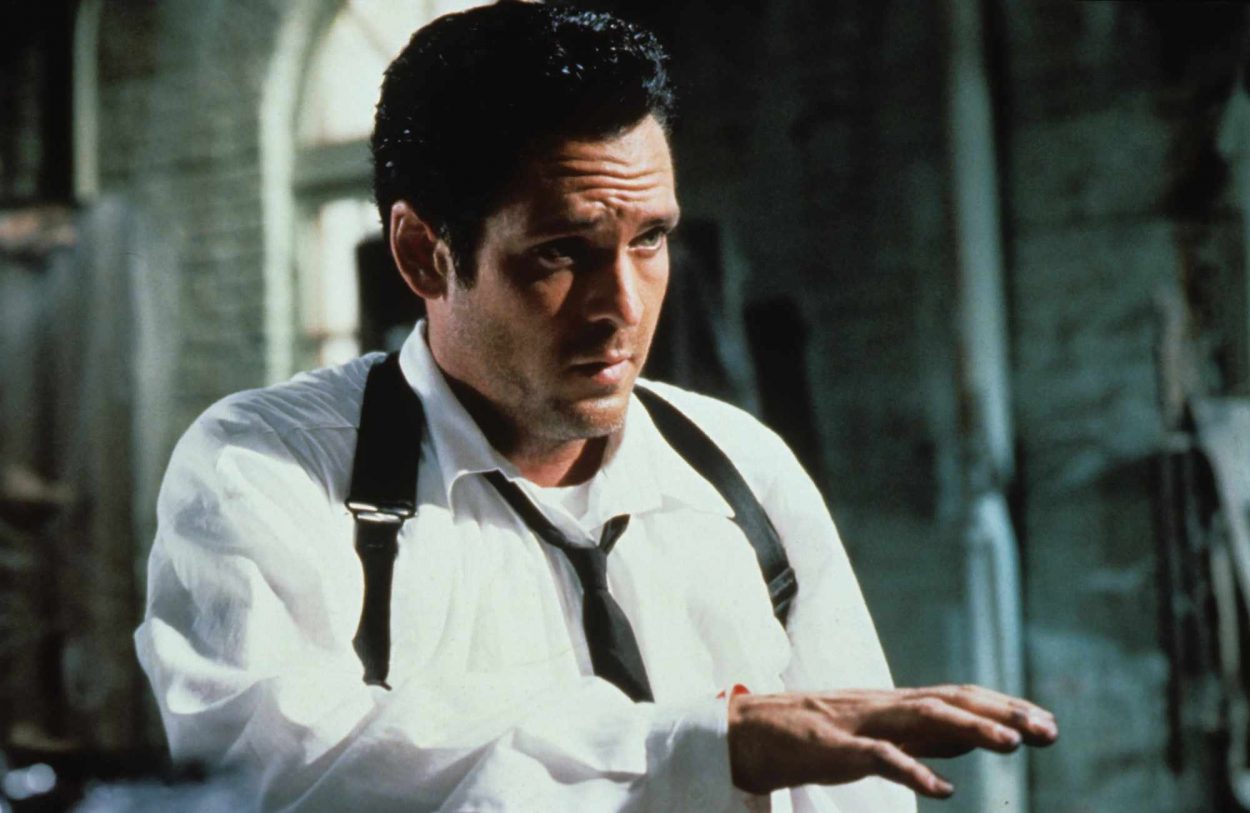One of the most acclaimed films of 2016 was Anna Biller’s beautifully staged satirical tragicomedy The Love Witch, telling the story of a glamorous woman drawn to supernatural practices who, in the course of seeking an ideal man, finds all of her conquests to be empty disappointments, while leaving betrayal and death in her wake. With imagery drawn from pulp novels, hard three-point lighting as seen in classic noir and Technicolor dramas, and acting based in archetypes rather than average behavior, all shot and edited on true 35mm film, it celebrates lost aspects of cinematic expression. These throwback elements, however, are in the service of a striking and firmly modern feminist point of view, addressing the impossible expectations foisted upon women for generations. As the frequently internet-engaging director stated on Twitter, “My work comes from a place of being female, and rewrites film genres from that place.” The heady brew of ideas in her film has left audiences, well, spellbound.
Our Saturday, January 21st midnight show, Jose Prieto’s 1967 Shanty Tramp, may not appear to have much in common with Biller’s arthouse hit, any more so than one would serve Waffle House hash browns at a Victorian high tea. But there is a unique sort of kinship, in theme and in work ethic, between these divergent projects. And since The Love Witch is enjoying a healthy Los Angeles run, patrons from those screenings who come to ours with her movie still fresh in their heads may well derive an added amount of enjoyment from both films.
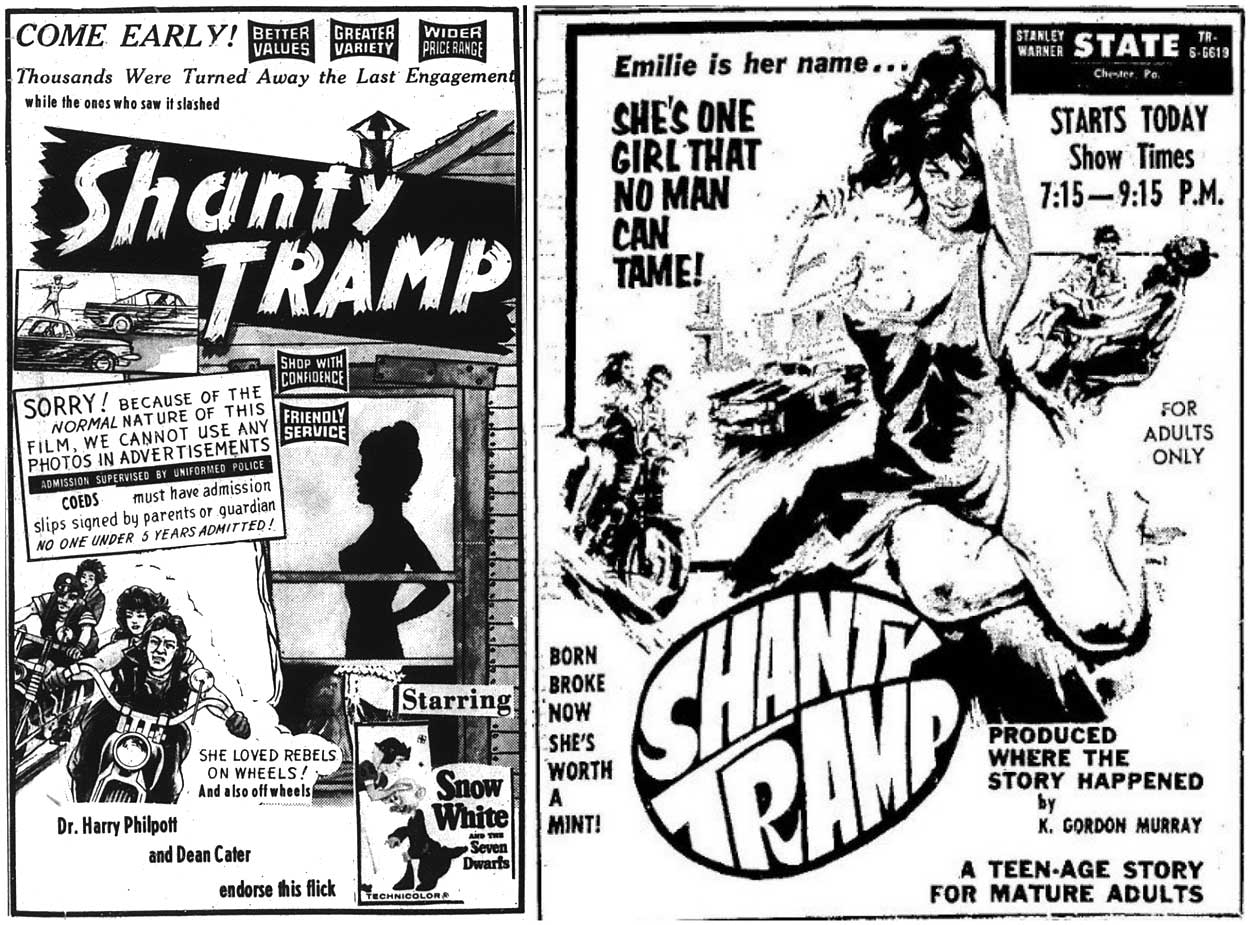
The title character in question is Emily (Eleanor Vaill, credited as “Lee Holland”), who lives in poverty with her ne’er-do-well father (Otto Schlessinger, credited as “Kenneth Douglas”), and spends her time looking for good sex, cold cash, or preferably both, to mollify her rancid circumstance. In one fateful night, she gets propositioned by a silver-tongued traveling preacher (Bill Rogers), toys with a would-be beatnik, runs afoul of an abusive biker (Lawrence Tobin), and briefly finds satisfaction with a good man (Ray Aranha, credited as “Lewis Galen”). Unfortunately, that man is black, and when her father catches them in the act, violent fiery repercussions and murder will follow.
Shanty Tramp was the first original narrative film produced by former carnival operator K. Gordon Murray, who had previously become synonymous with profitably reformatting foreign-made films into American hits, Rene Cardona’s 1959 Santa Claus and an early Santo wrestling adventure retitled Samson vs. the Vampire Women among them. Stars Vaill and Rogers had appeared in a Coral Gables production of The Fantasticks in November 1966 and were recommended by their stage director to Herschel Gordon Lewis, who cast them in A Taste of Blood in early 1967; Schlessinger and Tobin, co-stars from Blood, were recruited to appear with them in Tramp shortly after. A crew of mostly Cuban expatriates, led by director Jose Prieto, who all previously worked on the English dubbing of Murray’s Spanish-language pickups, made the film in the Miami metropolitan city of Davie in the spring of 1967. Bob Clark, who recently enjoyed a large number of tribute screenings at our theatre this past December, was assistant director, one of his earliest film credits.
It is not the intent of this essay to propose these two films are equals. They come from different eras and states of mind. Shanty Tramp was made to cash in on the popularity of both “Southern discomfort” dramas and the rising freedom to depict adult topics on screen, while The Love Witch is the passion project of a thoughtful, focused auteur. And Biller has stated bluntly that, contrary to many film writers’ ascriptions, there was no inspiration from sex-driven exploitation films, her actors were not coached to mimic performances from such films, and her intent was never to emulate that genre. In keeping with that mission, no such suggestions are made, and none should be taken. What is present within these stated divisions between these two works is an intriguing overlap. Put it this way: when you pour foundation and post beams for a building, it’s not yet determined what it will turn into. These two movies share a structural design, but Murray and Prieto created a juke joint while Biller opened a think tank.
Older blog essays by Biller posted during the release of her 2007 film Viva delve into her scholarly interest in select filmmakers of the “sexploitation” era, and reveal a professional respect for their ideas and their determination. In an entry on Joe Sarno‘s All the Sins of Sodom, she wrote:
“The big, dirty secret in many 1960s sex films and pulp novels is that many women enjoy sex, and that they have sexual desires and fantasies of their own. Although this is a fact that must have been playing out in bedrooms everywhere for all of human history, it could not, for most of human history, be discussed in society, in literature, or in film…One finds a quality in much of this sex literature and film from the 1960s of curtains being ripped off houses and inhibitions ripped off psyches to reveal what’s really going on inside of peoples’ lives and minds…What’s most striking about this time period is, it’s a tiny window of time in which the male and the female unite against society at large in order to rally for sexual freedom. And thus, curiously, it’s one of the few times we find the battle of the sexes as expressed in culture actually diminished or put on the back burner.”
And in an entry on Andy Milligan‘s Torture Dungeon, she wrote:
“[He] had a real atmosphere, created for pennies, [and] it is not easy to create an atmosphere on any budget…[it] takes itself very seriously. It’s not trying to be schlock, it’s trying to be good. When I see that it’s very weird, because it’s what I do. I’ve never quite seen anyone do what I do before; that is, try to make a period masterpiece with no money and no help. It reminds me a lot of my Super 8mm stuff, where I made everything out of nothing, just hobbled it all together.”
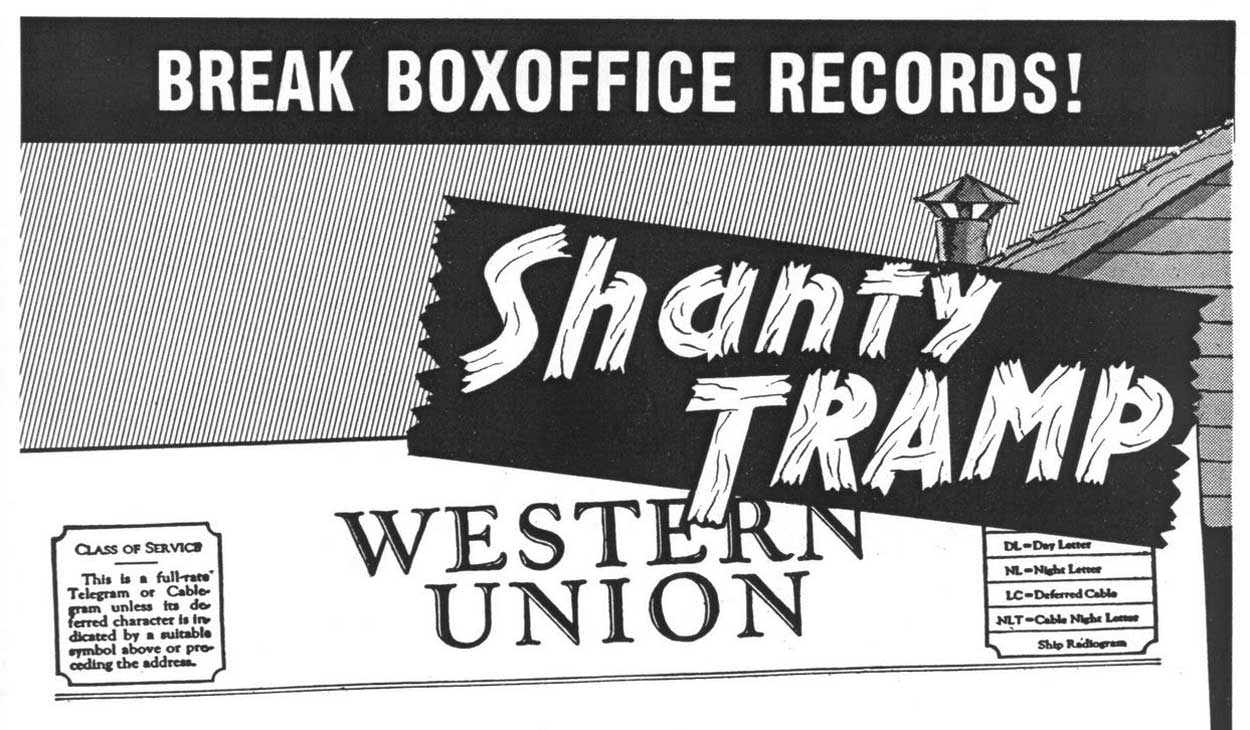
Murray and Prieto did not likely possess the curiosity of Sarno or the mania of Milligan, but in the manner of Biller’s observations, they understood there was a generational shift happening that should be addressed, and while they wanted to get a movie shot and released fast (Tramp premiered in Buffalo, NY, weeks after wrapping), they wanted to make it entertaining. Thus, despite their primary motivations for lucre, they managed to be on the right side of history and of the creative process.
From his years in both carny and cinema ventures, Murray could certainly claim expertise about the worst aspects of men, since they comprised his customer base. The kind who were decrying sexual libertinism in church and press, then lining up to see his dancing girls in a tent or his “hygiene films” at the drive-in. While hardly a progressive or a feminist, Murray, with his co-screenwriter Reuben Guberman, used this occasion to directly indict the very types that he knew would come to see a movie called Shanty Tramp, and throw their hypocrisy, their casual abuse of women, their racism and general brutality right in their face, under the pretense of promising Emily’s wanton pleasures writ large. Whether they got the message or not was likely irrelevant, since the ultimate goal was getting their box office money, but he got those licks in all the same. This assessment from Jacob Knight at BirthMoviesDeath tells it well:
“Murray (who co-wrote the script) and Prieto undoubtedly judge these poor bastards for being the reflexive hounds they are; lured by their dicks whenever a woman unafraid of her carnality is present. All men are dogs, but the meat they crave is sentient, wanting to pervert and discard their carcasses at will. [Vaill]’s performance (along with all of the other untrained thespians) is strange and affected, a dead-eyed China Doll with nothing but lust on her mind. Yet the non-actress recognizes the moments when the temptress appreciates how she can wield her sex like a weapon and use these mindless motherfuckers to her advantage…In this way, Shanty Tramp becomes a chicken and egg type moral parable, as Murray reveals the one thing he’d known his whole life: every person on this planet enjoys iniquity; it just takes a proper manipulative mind in order to exploit each individual’s unique perversion. But which came first: the sin, or the schemer?”
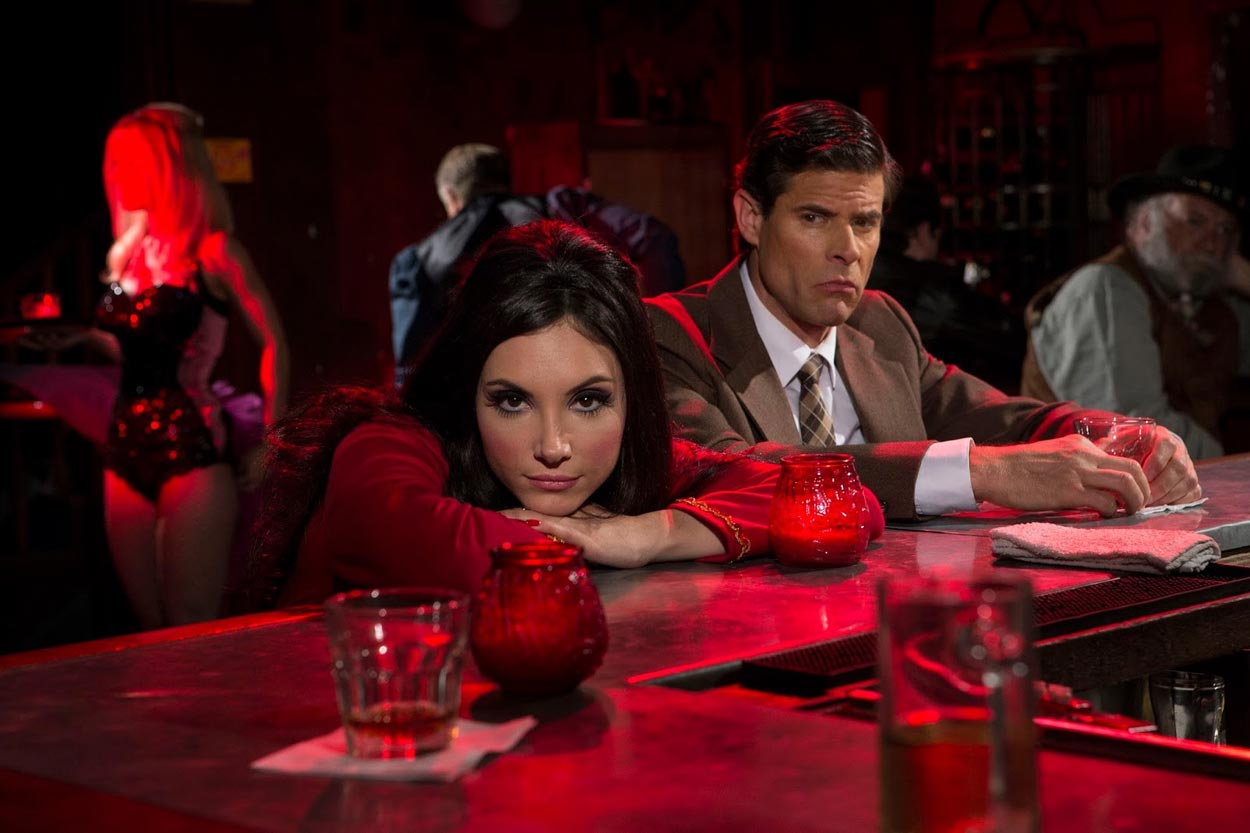
Again, though coming from a diametrical place, Biller expresses a similarly bleak assessment of men in general in her film. All of Elaine’s would-be paramours see her as a bauble and not a person, her supposedly enlightened pagan friends seem to be more interested in how their magick draws hot women to their enclave, and the other male townspeople quickly gather into a rape-hungry mob when Elaine is publicly accused of a criminal act. Not only does this echo Murray’s nihilism, it shows that in nearly 50 years, little has changed. And Biller’s description below of her heroine acknowledges mutual, though not equal, culpability about her fall on a par with Emily’s (writer’s note – paragraph cobbled from two different interview quotes):
“Elaine is not a monster, except insofar as she is selfish and narcissistic. She does not destroy out of some evil power, but because she is unstable and is the type of person who creates chaos around her. But she is fully human, and she is sympathetic because you can see why she’s turned out the way she has…Elaine is coping with a history of abuse the best way she knows how. Everything and everyone in society has conspired to make her what she is, so she can’t really be blamed for making the choices she makes. But she is also sociopathic, either from birth or through life experience or both. She is a psychologically realistic, dimensional character, who has been driven crazy just trying to negotiate her place as a woman in the world.”
Much like that ubiquitous drawing of literary heroines Dorothy and Alice having a chat, one could envision Emily and Elaine on a park bench sharing cigarettes and telling each other, “I’ve seen some weird shit.”
Murray was a wily, hands-on producer and marketer. For his foreign pickups, he worked out how to make his English dub tracks match lip movements. He would send actors dressed as fairytale characters to schools and hire hearse drivers to ferry coffins with ersatz zombies inside to theatres to promote his releases. When initial engagements of Shanty Tramp saw minors getting admitted to see the depravity without hassle, and the Dade County State Attorney’s office took action, he gleefully put text in his later ads warning that teens needed permission slips and doors would be “supervised by uniformed police.” He particularly loved narrating his own radio commercials, relying heavily on lurid copy and loud reverb effects on the title. And this one he voices for Shanty Tramp follows the same formula, promising it “makes those Swedish movies look like a Sunday School show.” (And Murray was a Knights of Columbus member, he knew all about Sunday School!)
While not a hard-sell ballyhoo merchant by comparison, with only two feature films and some shorts, Anna Biller has also successfully promoted herself as a brand. She began word of mouth on The Love Witch in 2011 on her blog, and frequently provided advance looks at the production on her various social media accounts. She spent years to make costumes and props, write music, and do other hands-on work for the film that would normally be farmed out to others, both to save money and to achieve her desired intents. After the film’s acquisition and release, she has made herself available to press, bloggers and fans on social media, and used these platforms to address other artistic and social issues that matter to her. She has become an inspiration to multiple groups who have long been ignored by Hollywood, demonstrating that staying true to yourself and going independent can pay off.
Despite all their probable philosophical differences, Murray would have been enormously impressed with Biller’s self-advancement. And, if he were alive and still in business today, after seeing her film, in the same manner that Warner Bros. revived interest in an older property by telling moviegoers, “Prepare yourself for The Exorcist with The Devils!”, Murray would likely be prepping a shameless “Before you see the Witch, see the Tramp!” revival campaign. As a convergent precedent, for a ’70s reissue through Jerry Gross’ Cinemation company, Tramp was paired with a controversial classic sublicensed from WB, Elia Kazan’s child-bride potboiler Baby Doll.
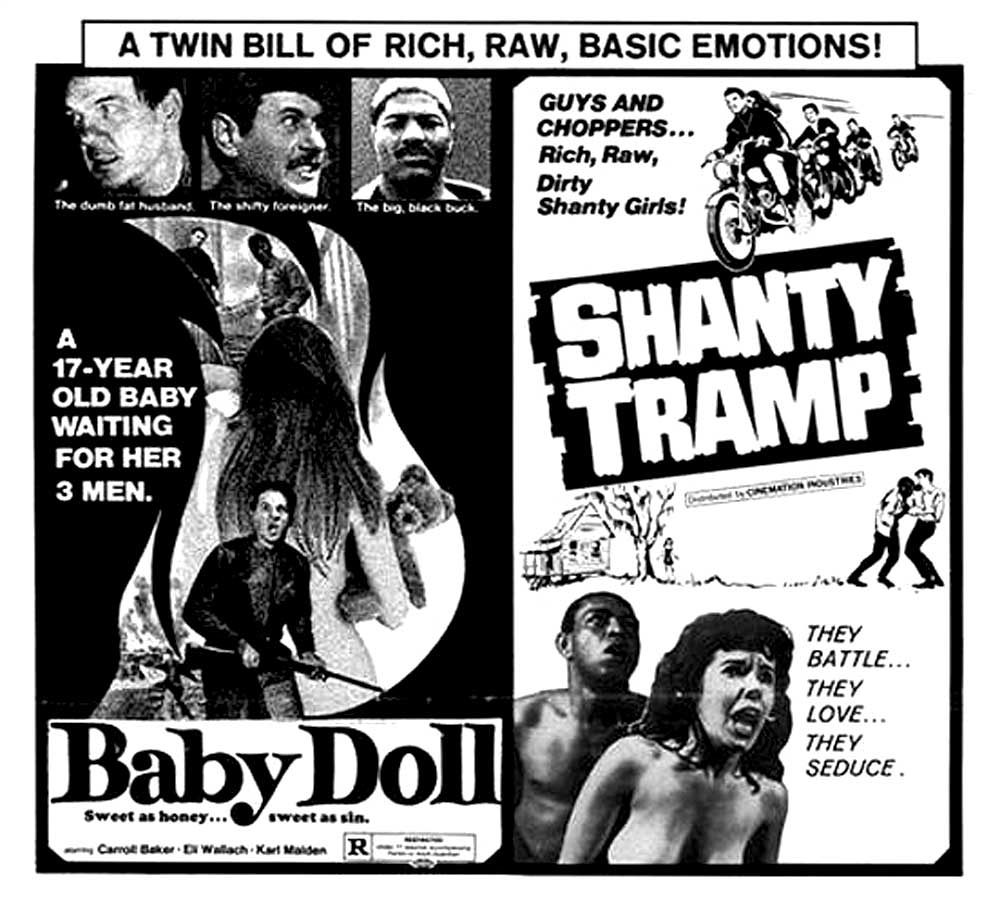
Whether you’re a cultural scholar interested in older cinematic depictions of sexual desire, or just a fan of bawdy exploitation, you should take advantage of this one night chance, this Saturday at midnight, to watch Shanty Tramp on the New Beverly big screen with an audience. Meanwhile, we also suggest you take advantage of the multiple opportunities to see The Love Witch; heck, since the movie’s available in 35mm, you may well see it on our screen some time. And if you get to see them both, you’ll have the launch for an interesting film conversation later on.
Shanty Tramp screens January 21.
Huge thanks to Daniel Griffith, Charles Kilgore and Anna Biller for their invaluable assistance in the assembly of this article.

